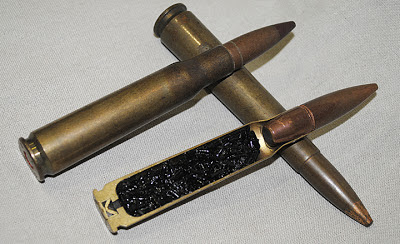Most of us have wondered what’s in a round of
ammunition. We visualize a gray colored
powder, maybe little translucent disks speckled with black compressed by the
copper bullet in a brass cylinder with the primer on the bottom. The chemistry is a mystery, as is much of the
round. Some have even proposed there is
a lawyer attached to each bullet leaving the barrel. Maybe there is.
Some of us have manufactured bullet cross-sections to
satisfy our curiosity. I have photos of
a .45 ACP cross-section I use in my training classes to illuminate the
mysterious round of ammo. Previously I looked at three
different .223 bullets in cross-section to better understand them. My good friend Marty has taken it a step
further and made a nice cross-section of a .50 BMG round, complete with inert
powder.
 |
| The maroon tip is a 1986 vintage 50BMG tracer. The other with it's gold tip is a mystery to me. The head stamp indicates it was made in 1942 at the Twine city plant. Ball ammo was unmarked. |
It makes a nice tool to explain
all the significant components of ammunition to students.
The Wired website has an artsy display of cross-sections of
real ammunition. http://www.wired.com/design/2013/07/incredible-cross-sections-of-real-ammunition/
They are the work of photographer Sabine Pearlman.
If you ever wondered what a cross-section of a Glasser
safety slug looks like or wondered about the Minie ball or a hardball 9mm, you’ll
find examples. Unfortunately Sabine
didn’t record any of the specifics so many of the rounds have interesting and
sometimes mysterious components implying specific but unknown purposes.
Can you find the hollow wooden bullet? It has a unique purpose, one you might not think of. I think there’s a shotgun shell used to start the
old rotary piston aircraft engines (maybe?).
Comments
Post a Comment